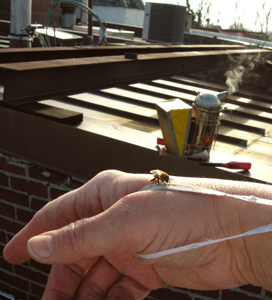
It's January, about the time that some queens around here are ramping up to begin laying again, coinciding with the first stirrings of the would-be bee people.
I've been getting emails from all around (and before you get the idea that this is a problem, please be aware that hearing from other would-be beekeepers absolutely makes my day). In California, in Oregon, and even around here, city and suburban folks have had some questions. From what goes on in face-to-face bee presentations and courses, this means that many, many others are too shy to step forward.
Well, you should, because you have friends out here, friends who are deeply committed to helping you and our six-legged (five-eyed, four winged…)friends.
To provide more immediate help, I want to mention some common threads that are emerging this year:
- Siting an urban or suburban hive;
- Choosing a race of bees;
- What about Top Bar Hives (TBH)?
- Finding local help; and
- What about the neighbors?
Before taking any of my advice, though, you should do two things: buy a good book (
here's a good one, but it could use an update), and meet a local beekeeper. When it all comes together in front of the hive, all the decisions will be yours, but you should expose yourself to as many sources of info as possible to make your choices as good as they can be(e).
1. Siting Your HiveThe place you put your bees' home is an important question for
everyone, but beekeepers in crowded locations face special extra concerns. The idyllic bee location is in a spot with strong morning sun, a bit of afternoon shade, facing South, near water, but not in a moist place. It should be out of sight of well-travelled roads or paths, and should not be in the same place as cows, horses, or other critters who can knock hives over or be trapped and stung up. Read your book to learn more about these particulars…
But, for the urban beekeeper, compromise is more likely. But be(e) of good cheer: some studies show that
urban bees are thriving when their rural or even suburban sisters are struggling a bit more.
Your priorities may differ, but mine go like this:
- determining whether bees can live in my neighborhood
- keeping bees and people from ruining each others' day
- ensuring that my access to the bees is safe for me; and
- perfecting (as well as I can) the location that meets the criteria above.
Can bees live with you? Almost certainly: people raise bees from the hot roofs of Texas to the cold plains of Alberta and beyond. So climate is probably not a problem. But it might not be legal to keep bees in your community: in many places it isn't. My commitment to the bees is such that I don't worry much about this, and am working to change laws and minds. In some places, especially those where Africanized bees are a real threat, you might not take it so casually. So if beekeeping is a shady business where you are, take precautions to stay below the radar, and try to understand why before moving forward.
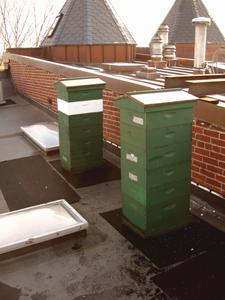
Staying on the down-low plays into my next point: find a place where your bees cannot be seen easily from public pathways or roads if at all possible. Vandalism (and theft!) are major sources of bee losses. Consider investing in potted shrubs or privacy fencing, if possible. If you have no place on your property which is suitably private, I strongly suggest finding an "outyard" nearby. Beekeeping clubs get calls all the time from people seeking bees for their gardens or parks, etc. I have bees in two such locations, and they are a real resource when I have to manage the roof girls.
Next, sun versus shade, and the direction in which the hive faces are usually not 100% in control of the urban dweller, and your bees can cope. Your first concerns, the safety of passersby and the security of your bees, will probably limit this choice, anyway. I suggest that ANY sun is better than none, and situating a hive entrance AWAY from the wind can help with a lack of sun. My home hives don't have a southern exposure, and they are fine. If you think your site will be unusually hot, consider available cooling options (provide shade artificially, or use a
Bee-Cool, for instance).
Finally, it can be useful to get your bees to fly upwards as soon as possible—above person height—by placing the hive entrance opposite (maybe 2 feet away from) a fence or a hedge or some other vertical obstacle. The less time the bees spent below 6 feet (or two meters) the better. By the way, getting the bees to fly high is one reason why balconies and porches, as well as your roof, can make great hive locations. Just remember, you have to be able to get to the location while carrying many pounds of tools and supplies (like sugar water). While you are there you will be manipulating woodenware and (eventually) carrying away 60-90 pound honey supers!
Some of you may wonder why I did not put anything in here about placing certain plants around the hives, or ensuring that your yard has a garden, etc. The reason is this, oh urban dweller: your bees will forage for 2 miles in every direction, making millions of trips to hundreds of thousands of plants. What you can plant in your city yard could not support one tenth of a hive. When you place your hive(s) in your city backyard, you are placing a bet on the viability of your entire environment, and the planting choices of your neighbors, your city park managers, and the people who water the tree boxes along the streets. Gulp! But it seems to work.
2. What Race of Bees?There are lots of races, but there are only two I know much about: Italians and Carniolans. If there was a third, it might be "local," but those are genetics I am only just learning about, and you should, too. I've heard good and bad things about Russian stock, but that's all hearsay, and I can give a shout out to this one beekeeper in Philadelphia who keeps Buckfast bees, but this is what I have to say.
Italian bees seem to require higher temperatures in order to work than the Carnies, and they need to winter over in larger numbers, but they are less likely to swarm and they are really gentle. A good starter bee. They are easy to find.
But I have had Carnies, too, and they have done well. They come from Eastern Europe, where growing seasons are short and temperatures are lower. Because the weather is easier here, the bees tend to build up large populations and, therefore, to swarm. This can be tricky for a new beekeeper to avoid.
Now, there are other things beyond race to think about. You can get hygienic stock: I have worked with Hygienic Kona Carniolans, with good luck. Hygienic bees have been bred to be clean freaks, and get some disease resistance that way. Keep in mind, the time that the bees spend cleaning is not used for foraging or raising young, etc. That means somewhat less productive hives.
Finally, if you can possibly get locally bred bees, whatever your locale might be, that is the best thing to do. As Colony Collapse Disorder ravages the beekeeping business, regions that are able to produce stock adapted to their place and plants and weather will also be ensuring that the biosphere will have a surviving stock of bees to keep things blooming.
3. Top Bar Hives (TBH)This section will be much shorter. New beekeepers seem to be very into the idea of TBH this year, and it worries me. I am intrigued by TBH and am interested in experimenting, but thus far have found that beginning beekeepers need immediate, practical access to other experienced beekeepers in order to get themselves up to speed and their hives up to stable population and health. There is MUCH less help around for TBH, and the format is native to places that are extremely different from where I live. Since having the bees here, I have continuously called on other beekeepers to borrow some equipment, to get advice, or to compare notes.
That being said, there are helpful people online, and maybe near you.
Michael Bush at Bush Bee Farms has helped alot of people, and knows much more about TBH. Folks, I'm not sure why all you have such an interest, though. You can do organic beekeeping in a Langstroth hive, after all, and the girls are fascinating in any housing arrangement.
4. Finding Local HelpIf there is one law of beekeeping, it should be this: no one should get their hands on bees before spending time with a beekeeper. Hey, I was a smarty-pants college kid with good homework habits once myself, and I can assure you that book learning is no great comfort the first time you go about installing a package of bees. Then in the panicky weeks after, when I assure you that at least 60% of new beekeepers become convinced that they have killed their queen, you will want someone to call. Or several someones. And maybe someone to come over and have a look (and a beer). Folks: this is the truth I am telling you.
So find a local club. Take a local short course: they are cheap or free, will hook you up with local bee suppliers, and will give you a basic clue about what to expect in your first year and all the seasons to follow. I don't care if you are shy (believe it or not, I'm an introvert). Just go. And try to be brave enough to ask questions: it is an incredible public service to the many people who will be more shy than you.
How to find a local club? In the US, I would check out the links at the Eastern Apicultural Society (
www.easternapiculture.org) if you live east of the Mississippi. In the west, you should google your state beekeeper association. Anywhere else in the world, check out
www.beehoo.com. If you run into trouble, ask me for a hand.
5. What About the Neighbors?This was the single most worrisome topic for me, and rightly so. I decided not to tell anyone, because my bees were a minority of the stinging insects on my block, they were placed responsibly, and I was worried that in these freaky times that people would carry on like, well, freaks.
In my case, I needn't have worried. I mostly got found out, there were no problems (so far). Right now, the amount of news coverage devoted to the plight of the honeybee is definitely a support for your decision to keep bees. If you know your neighbors well, and think you might get a good collaboration/cooperation going with them on this, it might be worth the risk of telling them. In my experience though, more than 50% of the public absolutely believes that they are the 1 in 10,000 who will go into anaphylactic shock if stung by a honeybee. They have probably never even been landed on by a honeybee, but have had some nasty past pas-de-deux with a yellowjacket. It takes a lot of talking and a good personal relationship to get beyond that kind of fear. At this point, I am very glad to have outyards available to me, should I need to move my bees (and yes, moving bees is possible—it happens all the time). If you are worried about the neighbors, consider arranging an outyard.
Finally, the EndThis got very long, and very bossy, it seems. I hope it did not dissuade you. One of the things about beekeeping is that there can suddenly be alot to know, and you can feel overwhelmed.
But you DON'T need to know everything at once, and if you work alongside another person who has been through many of these things, it makes sense rather than seeming like a dreadfully long list of things to memorize.
Even this long post is really a series of "if then, then this/if not, then that." It can be dizzying.
But your case will be rather more specific, and special to you. Your honeybees will integrate in an important and beautiful way with that particular environment around you, and you will get a wonderful chance to learn its ins-and-outs. For anyone like me to spin out a series of guesses about how things might work out for you is necessarily confusing and ugly. But your honeybees will be anything but ugly: golden angels with a world made out of flowers and a wake made up of growth.
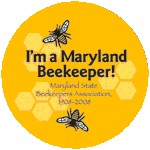 I'm not very good at being a secret beekeeper, despite my plunge into silence here over the past few months.
I'm not very good at being a secret beekeeper, despite my plunge into silence here over the past few months.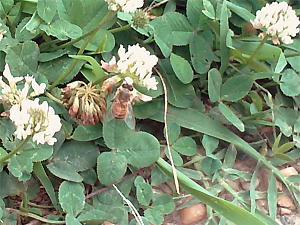 The nectar flow ended here between two and three weeks ago, though we still have many flowers in gardens doing their best to keep the girls busy. One thing I have been taught to look for, but which has eluded me in the three beekeeping Springs before this one, is a secondary nectar flow from white clover.
The nectar flow ended here between two and three weeks ago, though we still have many flowers in gardens doing their best to keep the girls busy. One thing I have been taught to look for, but which has eluded me in the three beekeeping Springs before this one, is a secondary nectar flow from white clover. 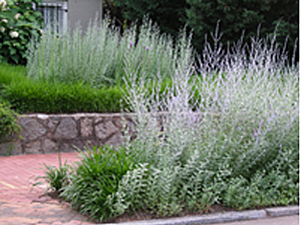 Sadly but predictably, just today it appears that the mowers came to the cemetery, and wiped out at least an acre of bobbing white heads of clover. Well, it is mostly a cemetery, not a dog park and nature lab. Besides, there are still many millions of plants all around the neighborhood, though not where I could so easily visit with them. The picture at right shows one of many stands of Russian Sage that are already delivering the goods to the bees, and they are likely to keep doing so right through August.
Sadly but predictably, just today it appears that the mowers came to the cemetery, and wiped out at least an acre of bobbing white heads of clover. Well, it is mostly a cemetery, not a dog park and nature lab. Besides, there are still many millions of plants all around the neighborhood, though not where I could so easily visit with them. The picture at right shows one of many stands of Russian Sage that are already delivering the goods to the bees, and they are likely to keep doing so right through August.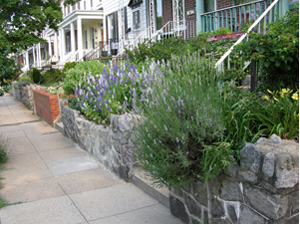 This year the lavender is very bloom-y here in the neighborhood as well. I wonder if this year's honey will have additional sharp sweetness from the clover, and some extra floral dimension from the lavender. Hey, I like it just fine in its basic Tulip Poplar, Black Locust, and Basswood formulation, but life always rolls out a new angle.
This year the lavender is very bloom-y here in the neighborhood as well. I wonder if this year's honey will have additional sharp sweetness from the clover, and some extra floral dimension from the lavender. Hey, I like it just fine in its basic Tulip Poplar, Black Locust, and Basswood formulation, but life always rolls out a new angle.

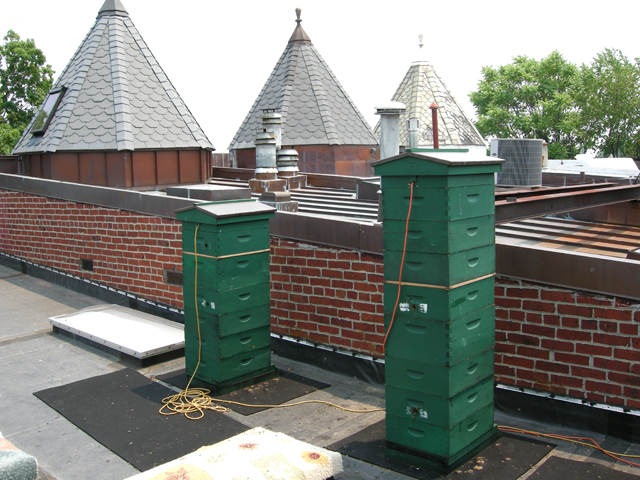 Hey there, remember me? Truth is, I almost wish you didn't (*if* you do remember, that is). I've spent the past 6 months just wondering what to say about the bees and my beekeeping and this whole great adventure. Just like a letter you keep meaning to write, knowing what to tell you has grown more difficult with each passing day. I started this post on March 5, 2008, more than three months ago. And I still can't decide what was going on then (or now).
Hey there, remember me? Truth is, I almost wish you didn't (*if* you do remember, that is). I've spent the past 6 months just wondering what to say about the bees and my beekeeping and this whole great adventure. Just like a letter you keep meaning to write, knowing what to tell you has grown more difficult with each passing day. I started this post on March 5, 2008, more than three months ago. And I still can't decide what was going on then (or now).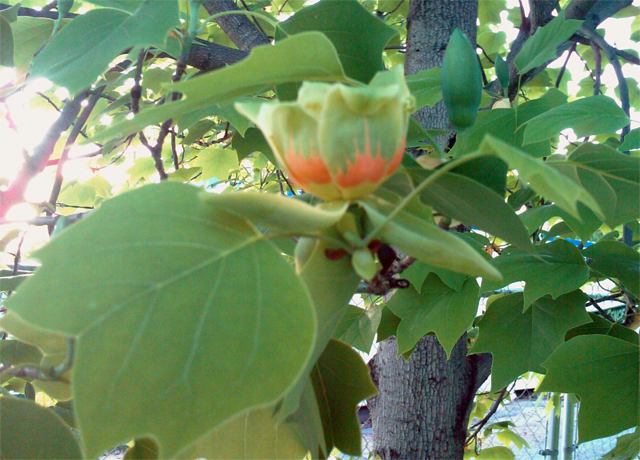 I can tell you one story after another about this year, each one ending with "In about a week when I check back in I hope to be able to give you an answer." This picture was taken on April 24, the date of the first tulip poplar bloom in my neighborhood, and the official beginning of the one great flow of nectar goodness that the bees enjoy each year. It also marks the last time I saw eggs in any of my in-town hives. Let me show you what I mean...
I can tell you one story after another about this year, each one ending with "In about a week when I check back in I hope to be able to give you an answer." This picture was taken on April 24, the date of the first tulip poplar bloom in my neighborhood, and the official beginning of the one great flow of nectar goodness that the bees enjoy each year. It also marks the last time I saw eggs in any of my in-town hives. Let me show you what I mean...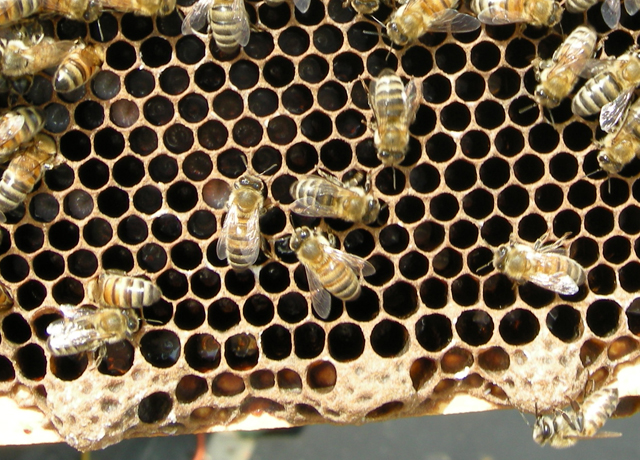 I'm wearing even stronger glasses this year, so at first I thought my eyes were failing me, and I used my camera to take close ups of the frames — back at my desk I can look at them at high resolution and often see things that get by me in real life. The camera only saw what I did, though: over and over again, I found only 3+ day old brood in the city colonies. All four colonies.
I'm wearing even stronger glasses this year, so at first I thought my eyes were failing me, and I used my camera to take close ups of the frames — back at my desk I can look at them at high resolution and often see things that get by me in real life. The camera only saw what I did, though: over and over again, I found only 3+ day old brood in the city colonies. All four colonies. 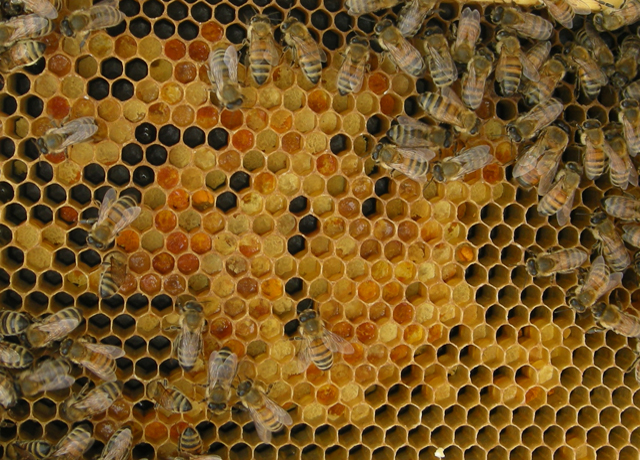 MaryEllen hazarded an explanation based on our weird Winter and the pattern of Spring weather: the bees came through strong and populous because the cold weather was not that cold, and they ate alot of the stored pollen. She knows that I have never supplemented pollen (
MaryEllen hazarded an explanation based on our weird Winter and the pattern of Spring weather: the bees came through strong and populous because the cold weather was not that cold, and they ate alot of the stored pollen. She knows that I have never supplemented pollen ( It's January, about the time that some queens around here are ramping up to begin laying again, coinciding with the first stirrings of the would-be bee people.
It's January, about the time that some queens around here are ramping up to begin laying again, coinciding with the first stirrings of the would-be bee people.  Staying on the down-low plays into my next point: find a place where your bees cannot be seen easily from public pathways or roads if at all possible. Vandalism (and theft!) are major sources of bee losses. Consider investing in potted shrubs or privacy fencing, if possible. If you have no place on your property which is suitably private, I strongly suggest finding an "outyard" nearby. Beekeeping clubs get calls all the time from people seeking bees for their gardens or parks, etc. I have bees in two such locations, and they are a real resource when I have to manage the roof girls.
Staying on the down-low plays into my next point: find a place where your bees cannot be seen easily from public pathways or roads if at all possible. Vandalism (and theft!) are major sources of bee losses. Consider investing in potted shrubs or privacy fencing, if possible. If you have no place on your property which is suitably private, I strongly suggest finding an "outyard" nearby. Beekeeping clubs get calls all the time from people seeking bees for their gardens or parks, etc. I have bees in two such locations, and they are a real resource when I have to manage the roof girls.